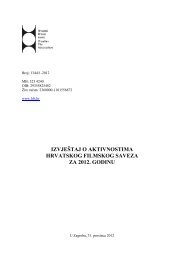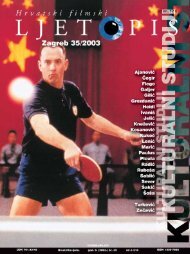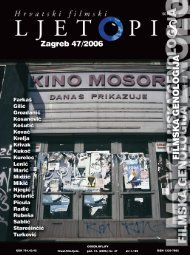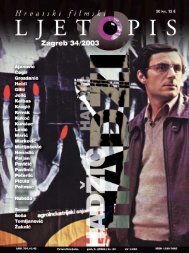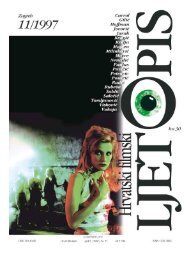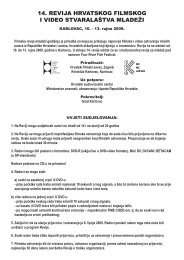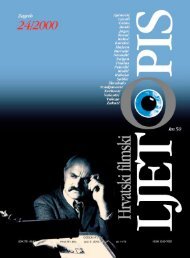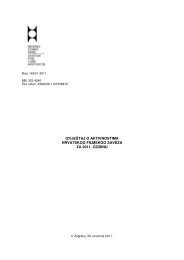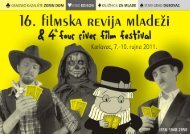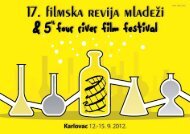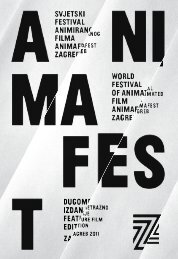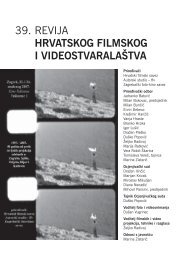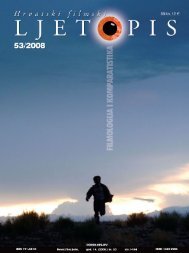Hrvatski filmski ljetopis, broj 26 (2001) - Hrvatski filmski savez
Hrvatski filmski ljetopis, broj 26 (2001) - Hrvatski filmski savez
Hrvatski filmski ljetopis, broj 26 (2001) - Hrvatski filmski savez
You also want an ePaper? Increase the reach of your titles
YUMPU automatically turns print PDFs into web optimized ePapers that Google loves.
The basis for computer digital nonlinear editing is the concept<br />
of true random access. In other words, any frame of<br />
film can be accessed in any time and order. Practical implications<br />
of this concept on the creative process and its final<br />
result are immeasurable.<br />
The computer digital nonlinear editing obviously brought<br />
many improvements in the process of editing. Much of the<br />
time spent on manual work is now free for creative work.<br />
Instant reviewing on the set enables the author to find the<br />
best solutions on the spot, to make quick changes as well as<br />
easily preserve several versions of the same sequence.<br />
Multilayered editing enables the author to work directly on<br />
the visual structure of the frame, that is to say, in-frame editing,<br />
which created a completely new form of editing expression<br />
while also opening new creative possibilities in the field<br />
of sound. Simplified communication resulted in a much better<br />
interaction with other postproduction departments consequently<br />
resulting in more creativity and smaller editing<br />
and production costs.<br />
Digital technology, computers particularly, in the editing<br />
process and the production as a whole represent an ideal<br />
mixture of traditional and contemporary trends. The best of<br />
traditional film editing, i. e. the concept of nonlinear editing,<br />
was merged with all the advantages of digital technolgy.<br />
The result was a much more pleasant and effective working<br />
atmosphere and a technical base for the evolution of the<br />
process of editing, especially the evolution of its creativity.<br />
Judging by what we know now, these changes are only the<br />
beginning. Next step is the transformation of the medium<br />
itself. First major development in that sense was already<br />
achieved by the replacement of the film negative (35mm)<br />
with the video format of the same or higher quality (High<br />
Definition TV format). At present a yet newer format is<br />
being introduced, 24p, Sony’s new format also called digital<br />
cinema. Its resolution of 1920x1080 pixels is very close to<br />
the film 2K resolution (2000 lines). By its technical characteristics<br />
(16: 9 format, 2K resolution; 24 frames per second)<br />
this digital standard is the closest to the 35mm film.<br />
At the same time, various experiments are being carried out<br />
all around the world, which do not necessarily have anything<br />
to do with film industry, nevertheless, could soon<br />
make a significant impact on it. Experts are working on the<br />
techniques of picture presentation (2D and 3D) directly on<br />
the retina. They are trying to incite the brain to receive outside<br />
information directly via radio waves, avoiding sight and<br />
hearing. Another type of experiments concerns the presentation<br />
of film picture and surround sound in its full quality<br />
over the Internet. One should not forget the experiments<br />
with virtual reality.<br />
The consequences of these new developments will undoubtedly<br />
be grand. Any time soon, we will most probably edit a<br />
virtual 3D action in real space. Nevertheless, no matter how<br />
dramatic these changes may be on the level of editing<br />
expression, the editing process, in its foundations, remains<br />
the same. The work will still consist of shortening material<br />
to a needed length, creating adequate temporal and spatial<br />
202<br />
<strong>Hrvatski</strong> <strong>filmski</strong> <strong>ljetopis</strong> <strong>26</strong>/<strong>2001</strong>.<br />
relationships, dynamics and the dramaturgical structure of<br />
the story. However, technical changes and new working<br />
methods are opening doors to creativity and enable us to<br />
travel in a number of new directions where the only limitation<br />
is — our own imagination.<br />
UDC: 791. 44. 071. 1 (438) Dumala P.<br />
781. 43 — 252 (438)<br />
Midhat Ajanovi}<br />
Brilliant Nuances of Darkness —<br />
Piotr Dumala’s Animations<br />
Polish animated film belongs to the leading film industries<br />
in the world when we take into consideration its creative<br />
achievements and a number of minutes of animation produced<br />
in one year. The pioneers of Polish cinema viewed<br />
animation as a very important genre from the very beginnings,<br />
if not the most important. In practice, animation<br />
started to develop in Poland after 1916 when Felyks<br />
Kuczkowski made his first animated film, while Zenon<br />
Wasilewski founded the first studio for animated film<br />
Triofilm at the end of 1930’s. Until the end of World War II<br />
nothing much was happening, but then in 1950’s started the<br />
golden age of animation in Poland. Four different studios<br />
for animation were founded, in Bielsko-Bialama, Krakow,<br />
Lodz and Warsaw creating a precious and unique cinematic<br />
and historical phenomenon. At the same time, with a number<br />
of over 2000 animated films produced Poland is one of<br />
ten countries with the richest production of animation.<br />
Polish animation is characterized by absurd, macabre films,<br />
films with nightmarish atmosphere achieved through brave<br />
and original experimenting with unique graphics techniques<br />
and audiovisual processing of the film form. Polish animators<br />
Jan Lenica, Walerian Borowczyck, Witold Giersz,<br />
Miroslav Kijowitcz, Ryszard Czekala, Daniel Szczechura,<br />
Zdislav Kudla, Jerzy Kucia or Zbigniew Rybczynski preferred<br />
working with unusual forms of expression; using<br />
methods of model animation, collage and flicker rather than<br />
those of classical animated film.<br />
Sophisticated artistic and animation forms were combined<br />
with a literary content and typically middle European characters,<br />
pessimists making fun at their own expense, laughing<br />
at the hopelessness of their situation in the world resembling<br />
a gigantic trap they are caught in. Totalitarianism of the<br />
modern age, which has left deep scars on Poland, was best<br />
portrayed in the animated medium.<br />
These films superbly developed a certain surreal visual language<br />
that described the subconsciousness and dark nightmares<br />
of lonesome losers, their anguish in the ambiance of<br />
entrapment they were born into. Painting absurd, often<br />
morbid dreams of these pessimists who have lost all their<br />
illusions, human caricatures that wander through the tunnel<br />
with no entrance nor exit, Polish animators spoke about<br />
their reality, political system and the society they grew up in<br />
and harshly criticized it.



